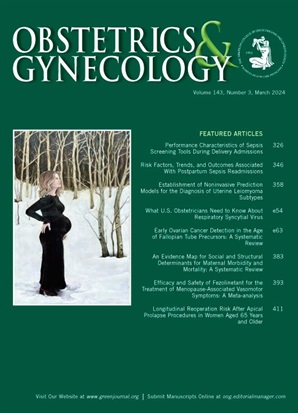第二阶段推压时机对产后盆底发病率的三年疗效。
IF 4.7
2区 医学
Q1 OBSTETRICS & GYNECOLOGY
引用次数: 0
摘要
目的比较二产程即刻推术和延迟推术对盆底主客观远期疗效的影响。方法:这是一项多中心随机对照试验,纳入了妊娠37周及以上的无产患者。参与者在分娩第二阶段被随机分配到立即推或延迟60分钟后推。产后1-5天、4-8周和2-3年进行盆底评估。盆腔器官脱垂量化(POP-Q)测量和验证问卷评分(PFDI-20[盆底窘迫量表]、PFIQ-7[盆底冲击问卷]、FISI[大便失禁严重程度指数]和MMHQ[改良曼彻斯特健康问卷])评估在立即推压组和延迟推压组之间进行比较。产后1-5天和2-3年分别进行盆底问卷评估。分别于产后4-8周和2-3年进行POP-Q检查。问卷得分的变化根据出生体重超过4000克和分娩持续时间进行调整。结果2014 - 2017年共纳入2414名受试者。356名妇女(14.7%)在2-3年时完成了盆底评估,其中175名在立即推压组,181名在延迟推压组。排除间隔妊娠患者(n=236)。产后2 ~ 3年的POP-Q分期差异无统计学意义。产后2-3年PFIQ、FISI和MMHQ总分和亚量表评分组间和组内差异无统计学意义(分别为-12.8±47.2 vs -22.0±58.7,P= 0.09; -1.2±8.0 vs -0.6±7.7,P= 0.56; 3.1±22.5 vs -0.1±20.2,P= 0.53)。两组PFDI-20评分差异无统计学意义(3.4±29.1 vs 0.4±36.2,P= 0.40)。然而,结直肠肛肠窘迫量表得分变化差异有统计学意义(2.4±16.0 vs -5.7±15.7,P= 0.01)。结论在第二产程无产患者中,立即推压与延迟推压在2-3年时的POP-Q测量值和大多数盆底症状没有显著差异。临床试验注册:clinicaltrials .gov, NCT02137200。本文章由计算机程序翻译,如有差异,请以英文原文为准。
Three-Year Outcomes of Second-Stage Pushing Timing on Postpartum Pelvic Floor Morbidity.
OBJECTIVE
To compare the long-term pelvic floor subjective and objective outcomes of immediate and delayed pushing in the second stage of labor.
METHODS
This was a multicenter randomized controlled trial that included nulliparous patients at 37 weeks of gestation or more in labor with neuraxial analgesia. Participants were randomized in the second stage of labor to immediate pushing or pushing after a 60-minute delay. Pelvic floor assessments were performed 1-5 days, 4-8 weeks, and 2-3 years postpartum. Pelvic organ prolapse quantification (POP-Q) measurements and validated questionnaire score (PFDI-20 [Pelvic Floor Distress Inventory], PFIQ-7 [Pelvic Floor Impact Questionnaire], FISI [Fecal Incontinence Severity Index], and MMHQ [Modified Manchester Health Questionnaire]) assessments were compared within and between the immediate and delayed pushing groups. Pelvic floor questionnaire assessments were performed 1-5 days and 2-3 years postpartum. The POP-Q examinations were performed at 4-8 weeks and 2-3 years postpartum. Changes in questionnaire scores were adjusted for birth weight exceeding 4,000 g and duration of pushing.
RESULTS
A total of 2,414 participants were randomized between 2014 and 2017. Three hundred fifty-six women (14.7%) completed pelvic floor assessments at 2-3 years, 175 in the immediate pushing group and 181 in the delayed pushing group. Patients with an interval pregnancy were excluded (n=236). There was no significant difference in POP-Q stage at 2-3 years postpartum. Intergroup and intragroup changes in total and subscale scores for the PFIQ, FISI, and MMHQ were not significantly different at 2-3 years postpartum (-12.8±47.2 vs -22.0±58.7, P=.09; -1.2±8.0 vs -0.6±7.7, P=.56; and 3.1±22.5 vs -0.1±20.2, P=.53, respectively). The changes in PFDI-20 score were not significantly different (3.4±29.1 vs 0.4±36.2, P=.40). However, the Colorectal-Anal Distress Inventory subscale score change was significantly different (2.4±16.0 vs -5.7±15.7, P=.01).
CONCLUSION
Among nulliparous patients in the second stage of labor with neuraxial analgesia, immediate compared with delayed pushing did not result in significant differences in POP-Q measures and most pelvic floor symptoms at 2-3 years.
CLINICAL TRIAL REGISTRATION
ClinicalTrials.gov, NCT02137200.
求助全文
通过发布文献求助,成功后即可免费获取论文全文。
去求助
来源期刊

Obstetrics and gynecology
医学-妇产科学
CiteScore
11.10
自引率
4.20%
发文量
867
审稿时长
1 months
期刊介绍:
"Obstetrics & Gynecology," affectionately known as "The Green Journal," is the official publication of the American College of Obstetricians and Gynecologists (ACOG). Since its inception in 1953, the journal has been dedicated to advancing the clinical practice of obstetrics and gynecology, as well as related fields. The journal's mission is to promote excellence in these areas by publishing a diverse range of articles that cover translational and clinical topics.
"Obstetrics & Gynecology" provides a platform for the dissemination of evidence-based research, clinical guidelines, and expert opinions that are essential for the continuous improvement of women's health care. The journal's content is designed to inform and educate obstetricians, gynecologists, and other healthcare professionals, ensuring that they stay abreast of the latest developments and best practices in their field.
 求助内容:
求助内容: 应助结果提醒方式:
应助结果提醒方式:


